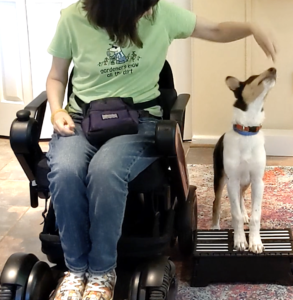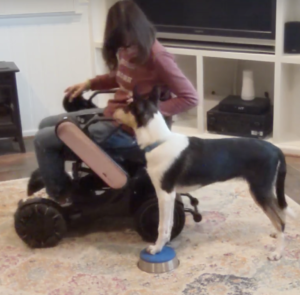Training a service dog to walk on a loose leash in a variety of distracting settings is always challenging, but when the handler uses a wheelchair, there are even more factors to consider. Wheelchairs take up more space, making it important for the dog to remain close to the handler in busy or crowded settings. However, if the dog is too close to the chair, the dog’s paws can get run over. The dog needs to learn how to keep pace with the wheelchair’s movements, which are different from those of a person who is walking.
Before beginning training, it’s good to plan for some logistical challenges. Depending on the type of wheelchair and the handler’s disability, delivering treats to the dog may be difficult. Accommodations for handlers with limited use of their hands may be needed. In some cases it may be easier for the handler to use a verbal marker, rather than a clicker.
Begin working with the dog off leash in a safely enclosed space. The first step is to train the dog the position they need to be in relative to the wheelchair when the wheelchair is not moving. You can shape the dog for being in the desired location next to the wheelchair. Platforms can also be very helpful at this stage of the process. The dog can first be trained to place their front feet on a small stool, and then stool can be placed next to the wheelchair in the position needed. After spending some time rewarding the dog for placing their paws on the platform, the use of the platform can be faded out.

When the dog is regularly approaching and standing or sitting in position next to the wheelchair, the next step is to add some movement. Begin by moving in a straight line, just a few inches forward, and mark and reward the dog for moving with the chair. Slowly work toward increasing distance, moving the chair forward and backward in a straight line.
Training the dog to turn with the wheelchair requires some additional considerations. The pivot point of each wheelchair is different. Manual wheelchair users often can make very tight turns. The pivot point of power wheelchairs, on the other hand, varies depending on their design. It’s important to train the dog in a way that ensures the dog is not hit by the chair when it turns. Platforms can be helpful here as well. A round platform can be used to train the dog to pivot. Service dogs do not need to turn on a dime, but they do need to be aware of their hind end movement in order to turn with the wheelchair in a tight space.

When the dog is maintaining the desired position in relation to the chair when the handler turns, the team can then start to mix up the movements. The handler can slowly work with the dog moving in a straight line forward and backward, and mix in various turns and pace changes.
When all of this is easy for the team without the leash, it’s time to add the leash back in. Selecting the right leash for this task also may take some experimentation (link to selecting the leash). The last step is to work with the team in other settings with distractions. A helper can be useful at this stage to hold a second leash, in the event that the handler needs to drop their leash.
Dogs who are walking on leash with a handler who uses a wheelchair need to be trained to walk on a loose leash extremely reliably. Moving a wheelchair requires more attention than walking, so the handler needs to multitask when moving the wheelchair and simultaneously training the dog. Additionally, handlers using wheelchairs cannot easily move away from approaching dogs, crowds and other distractions. By slowly and systematically increasing criteria, service dogs can learn to walk next to their handlers who use wheelchairs in a variety of different settings with ease and confidence.
